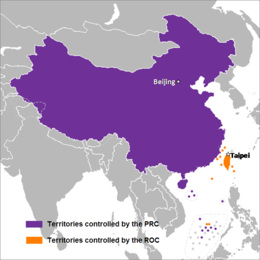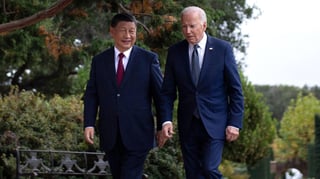
The term One China may refer to one of the following: The One China principle is the position held by the People's Republic of China (PRC) that there is only one sovereign state under the name China, with the PRC serving as the sole legitimate government of that China, and Taiwan is a part of China. It is opposed to the idea that there are two states holding the name "China", the People's Republic of China (PRC) and the Republic of China (ROC); as well as the idea that China and Taiwan form two separate countries. One China with respective interpretations refers to the interpretation of the 1992 Consensus asserted by the ROC's then-governing political party Kuomintang (KMT) that both the PRC and ROC had agreed that there is one "China", but disagreed on whether "China" is represented by the PRC or ROC. This interpretation of the 1992 Consensus has not been accepted by the PRC. The Democratic Progressive Party (DPP), the other major party of the ROC politics, has never acknowledged the existence of the so-called “1992 consensus” and also rejected any claim that both sides of the Taiwan Strait as "one China". And Lee Teng-hui, the President of the ROC from the KMT at the time, said no consensus had been reached in 1992 and claims to the contrary were "nonsense," and that the term was "something that former Mainland Affairs Council minister Su Chi (蘇起) fabricated to placate the KMT in 2000s,” which Su conceded in 2006. Prior to the 1991 constitutional amendments and democratization of Taiwan, the KMT-dominated Republic of China (ROC) government considered the ROC itself as the sole legitimate government of "China", which contested sovereignty over its constitutionally-defined territories, including the former late Qing dynasty borders of Mainland China, Tibet, Outer Mongolia, Tannu Uriankhai, and Badakhshan etc., and also legally designated the Chinese Communist Party as a "rebellious group". The One China policy refers to a United States policy of strategic ambiguity regarding Taiwan. In a 1972 joint communiqué with the PRC, the United States "acknowledges that all Chinese on either side of the Taiwan Strait maintain there is but one China and that Taiwan is a part of China" and "does not challenge that position." It reaffirms the U.S. interest in a peaceful settlement of the Taiwan question. The United States has formal relations with the PRC, recognizes the PRC as the sole legal government of China, and simultaneously maintains its unofficial relations with Taiwan while not recognising China's sovereignty over Taiwan. Internationally, it may also refer to the stance of numerous other countries. For instance, Australia's 1972 Joint Communiqué with the PRC recognised the Government of the PRC as China's sole legal government, and acknowledged the position of the PRC that Taiwan was a province of the PRC", but "neither supports nor opposes the PRC position" on the matter. While some countries, such as the UK, Canada, Australia, and Japan like the U.S. acknowledge but do not recognise the PRC's claim, the communiqués of some others, including Israel, Panama, and the Gambia, concurs with the PRC's interpretation. After the Chinese Communist Party (CCP) defeated the Kuomintang (KMT) in the Chinese Civil War and the subsequent retreat of the ROC to Taiwan, the CCP established the PRC in mainland China while the ROC ruled over Taiwan and several outlying islands. During this time, both governments continued to claim legitimacy as the government of all of China. Initially, international recognition of the two was split, but most countries began to recognize the PRC over the ROC in the 70s, including the United States in 1979. The language in the United States' One China policy first arose in its joint 1972 Communiqué with the PRC. Under ROC President Lee Teng-hui in the 1990s, the Additional Articles of the Constitution of the Republic of China were passed which effectively transformed Taiwan from a one-party state into a democracy, and limited civil and political rights to citizens in the "free area" (the area under its actual control, consisting mostly of Taiwan), but did not alter language regarding territorial claims or national territory. Subsequently, views on the One China principle in the ROC have been largely split along party lines: Pan-Blue coalition parties (including the KMT), which favor One China with respective interpretations, while Pan-Green coalition parties (including the Democratic Progressive Party) reject it. Meanwhile, the PRC has maintained its One China principle. From Wikipedia

Manila frames Lin Chia-lung’s trip as a private business visit to preserve unofficial ties.

